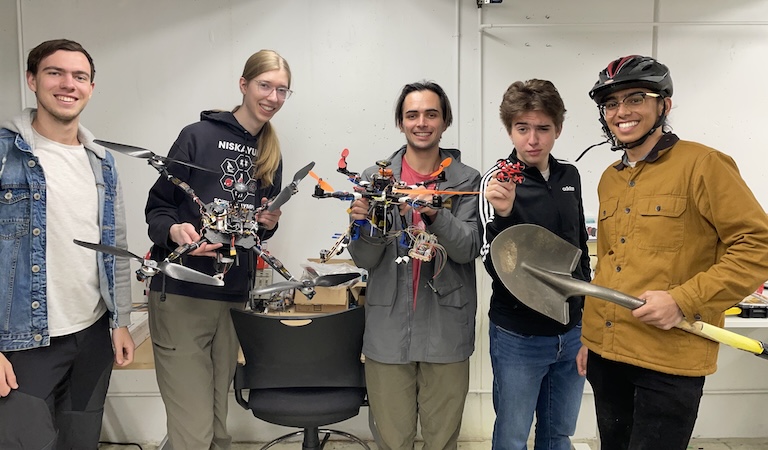Harvey Mudd Students Develop Demining Technology to Help Ukraine
June 6, 2024
A team of Harvey Mudd College students has leveraged existing drone technology to develop a safe and efficient way to detect landmines in Ukraine. The patent-pending technology has the potential to save lives by reducing risks associated with locating explosives while offering the war-torn nation an affordable and scalable removal option.
The project, with a working title of SafeLand Ukraine, is personal for Ivan Dudiak ’26, a physics major at Harvey Mudd, who grew up in an area of Ukraine now heavily affected by explosives used in the Russia-Ukraine war. Since 2022, over 1,150 civilians in Ukraine have been killed or injured due to landmines that remain buried in about 30% of the country. Dudiak’s family in Ukraine isn’t in imminent danger, but that wasn’t always the case. “My family spent a month under occupation before fleeing to Western Ukraine, and the effects of the occupation, compounded by ongoing conflict, always remain with us,” he says.

Wanting to leverage his learning at Harvey Mudd to help Ukrainians, Dudiak developed an idea in fall 2023 to better detect landmines with drone technology. He mentioned the idea to a friend, Xander Fries ’24, who researched companies producing similar technologies. Together, Dudiak and Fries began prototyping and testing solutions.
They reached out to Jason Gallicchio, associate professor of physics, who is familiar with drone technology. “When I told Professor Gallicchio about my idea, he was interested in helping however he could,” says Dudiak. “And, without his help, we wouldn’t have gotten very far.”
In addition to Dudiak and Fries, the SafeLand Ukraine team includes Carlos Ojeda de Silva ’27, Josaphat Ngoga ’26, Marina Bellido ’26, Lillian Vernooy ’25, Dominick Quaye ’25 and Danylo Kachur, who each played a part in the project’s success.
Ukraine loses over $14.5 billion annually in crop production due to landmines and metal contaminants from artillery exchange that destroy farming equipment. The process of demining comes at steep and dangerous costs, involving sappers who locate and remove the explosives manually. The country faces multiple challenges: significant areas to treat, a shortage of sappers (whose lives are risked performing the task) and a costly and inefficient process of removal.
“It would take an average farmer in Ukraine several years of income to cover expenses if his field is contaminated, which isn’t economically feasible,” says Dudiak. “The cost to demine Ukraine is over $26 billion, and the country simply can’t afford it.”

The project team’s design is a technology that uses rapid drone scanning to detect magnetic fields of mines. Its efficiency arises from a modular system attaching to an existing drone, performing about 100 times faster and offering a safer alternative than manual detection performed by sappers. The team has procured distributors in Ukraine for the final working prototype and the method the team developed to process data collected by the drone is now patent pending.
Dudiak anticipates that this technology can be offered to Ukraine at an affordable cost. “To manufacture each system is around $200 to $400, which is a more affordable option than competitor technologies that run $20,000 to $50,000 per unit,” he says. “Since the affordability makes it more scalable, we estimate that the value our technology can bring to Ukraine is around $8 billion in savings from expenses that will otherwise be incurred in the landmine clearance process.”
And the project’s potential impact hasn’t gone unnoticed: SafeLand Ukraine won first place at SageTank, a pitch competition run by Pomona Ventures, an organization of students from The Claremont Colleges, and a prize of $3,000 toward future system development. The team received support from the Harvey Mudd Shanahan Project Fund and a $20,000 gift from alumnus Andy Pham ’91 toward technical, testing and manufacturing project costs. The team also attended the 2024 IEEE Systems and Technologies for Remote Sensing Applications Through Unmanned Aerial Systems conference in New York and won the Best Student Presentation award.
Dudiak, Fries and Sorin Jayaweera ’26 are spending the summer at Harvey Mudd building a more robust system that can be scalable in Ukraine and will travel to Oklahoma to conduct field tests.
After graduating, Dudiak sees himself becoming a social entrepreneur in post-war Ukraine, supporting the recovery process. He says, “I may pursue a master’s degree in Europe related to applied physics or engineering and return to Ukraine using my technical skills to help the country and people rebuild.”
